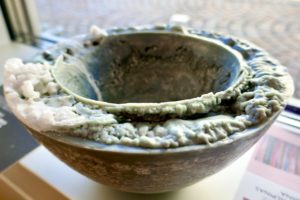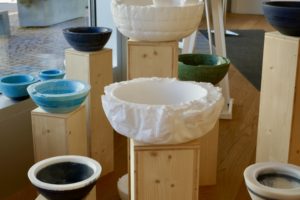News
The Coppas da Tschaira from Ernestina Abbühl – Wax, the Bronze Age & a Contemporary Conversation
The first time I encountered Ernestina Abbühl’s art, I directly resonated with her abstract representation of her four main themes: ice, rock, earth and alpine flora.  Her art struck me as striving beyond the obvious
Her art struck me as striving beyond the obvious
beauty that the Engadin is blessed with by investigating the power as well as the limitations of the natural wonders that constitute the alpine landscape. It was one of her reliefs that explores the different layers between ice and rock where I drew a direct connection to climate change and the contradiction between the majesty as well as the fragility of the alpine glaciers. The many layers of waxed papyrus create a solid, almost industrial, square-cut entity from afar but upon closer investigation her art works express a dialogue between the natural materials and the human interpretation and effect of these formations.
Her new exploration of ice, rock, earth and alpine flora reiterate these contradictions. Abbühl is once again uniquely creative with the most recent addition of her “Coppas da Tschaira” – the wax bowls –
which are currently on display in the Central Art Gallery.  She created each bowl by using various wax colours and textures, meaning that every bowl is an exclusive piece of art. Her creations return to a celebration of the unique, clearly contradicting the schools of thought that regard art as something that can be easily replicated such as Andy Warhol’s factory philosophy, which removes the artist from the somewhat industrial art production. Abbühl embodies the intricacy and manual talent of artistry as she pours the wax into a mould that resembles the practice of the Bronze Age. Her combination of traditional and ancient art practices with innovative experimentation and technique highlights the artist’s origin story as well as her curiosity for the reimagination of history.
She created each bowl by using various wax colours and textures, meaning that every bowl is an exclusive piece of art. Her creations return to a celebration of the unique, clearly contradicting the schools of thought that regard art as something that can be easily replicated such as Andy Warhol’s factory philosophy, which removes the artist from the somewhat industrial art production. Abbühl embodies the intricacy and manual talent of artistry as she pours the wax into a mould that resembles the practice of the Bronze Age. Her combination of traditional and ancient art practices with innovative experimentation and technique highlights the artist’s origin story as well as her curiosity for the reimagination of history.
 The wax bowls are not only unique in their creation but also have a positive effect on the fruits that the
The wax bowls are not only unique in their creation but also have a positive effect on the fruits that the
functional object can hold; the wax preserves the fruits for a longer period of time because of the natural conservation effect (very much falling into the sustainability trend of using wax paper instead of tin foil to cover foods). Using wax to preserve and store fruit was already implemented in the 13th century, which emphasises again how Abbühl transforms ancient practices into contemporary art.
by Léonie Kirchgeorg
